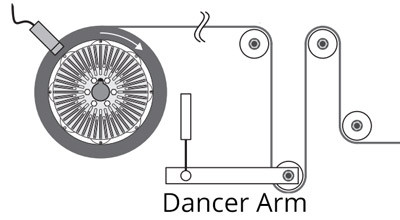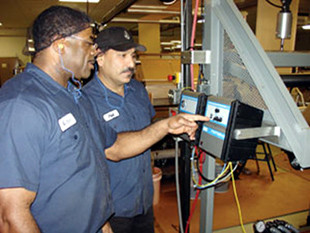Maintaining consistent tension is crucial when processing web materials across various industries, from printing to manufacturing. Inconsistent tension can lead to product defects, material waste, and inefficient operations. Dancer roll systems are engineered to address these challenges, acting as an integral component in web handling to ensure optimal and stable tension control. These systems are essential for preventing issues like telescoping, starring, or out-of-round rolls, all common roll defects that degrade product quality. A well-designed dancer system is a proactive solution to manage and mitigate inherent process variations, securing consistent web tension and superior output quality.
Understanding Dancer System Components
 Dancer Arm Diagram
Dancer Arm Diagram
At its core, a dancer roll system functions as a preloaded idler arm. This mechanism uses the web tension itself to dictate its force and positioning throughout the unwind or rewind processes. This inherent responsiveness to web dynamics makes the design of dancer systems paramount for achieving high-quality web handling. Without precise tension control, managing the web becomes virtually impossible. Dancer systems provide this necessary control, allowing materials to move smoothly and consistently through both unwind and rewind stages of production.
Key Tension Zones in Web Handling
Every web handling system is characterized by distinct tension zones, each requiring careful management for optimal quality and productivity. Tension zones are simply defined as the segments within a web where tension can be modified or influenced, typically between two driven points. Each zone is unique and necessitates an independent feedback loop to maintain precise tension levels. Generally, three primary tension zones are critical:
- Unwind Tension Zone: Located between the unwind drive and the master drive.
- Intermediate Tension Zone: Where the main web processing occurs, situated between the master drive and the slave drive.
- Rewind Tension Zone: Positioned at the end of the process, managing tension as the web is rewound.
Closed-Loop Control with Dancer Rolls
Within each tension zone, tension regulation is achieved through either open-loop or closed-loop control systems. Dancer rolls are specifically utilized in closed-loop tension control systems, preferred for their precision and responsiveness. Although dancer systems come in various designs—pivot arm, linear, and rotational—they share fundamental principles. Notably, they all incorporate preloaded idler rolls or arms, set to resist the web’s movement in one direction while reacting to tension changes in the opposite direction. As the web moves across the dancer roll, any shift in the web’s position is a direct indication of a change in web tension.
The Role of the Dancer Potentiometer
The position of the dancer roll is continuously monitored by a sensor, which is crucial for detecting and adjusting the drive’s operation. This sensor, known as a dancer potentiometer, is activated by any positional changes in the dancer roll resulting from tension fluctuations in the web. When tension varies, the dancer potentiometer signals the system to adjust torque—and consequently speed—to return the dancer roll to its original, pre-set position. In this way, dancer systems function more as position controllers that indirectly manage tension by precisely regulating web speed. By maintaining consistent speed, dancers ensure web tension remains constant, providing stable processing conditions.
Advantages of Implementing Dancer Control Systems
 Printing Press Operators
Printing Press Operators
Alt text: Operators overseeing a printing press, illustrating a practical application where dancer roll systems are essential for maintaining consistent web tension in high-speed printing processes.
A significant benefit of using dancer tension controls is their capacity to provide web storage. Dancer systems inherently accumulate a certain length of web material in the machine direction. This web accumulation is vital for absorbing tension fluctuations caused by factors like out-of-round rolls or splices passing through the system. By effectively smoothing out tension variations across different zones, dancer systems ensure that the web tension downstream remains uniform and stable. This accumulation feature also lends mechanical stability, particularly important during processes with large roll build ratios in unwind and rewind operations.
Web materials can range from delicate foils and thin plastics to robust textiles, papers, metals, and composites. Regardless of the material, the primary objective in web handling is to deliver the web at a consistent tension throughout the winding and unwinding phases. Dancer tension control systems are indispensable for managing web tension and accurately positioning material as it moves through web machinery for processing. Without the application of correct tension, effective web control is simply unattainable. Dancer roll systems provide the reliable and responsive tension management necessary for high-quality web processing and product integrity.

